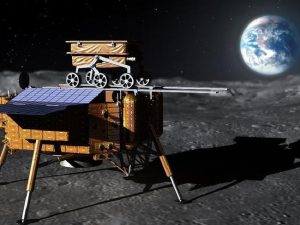
By Andrew Jones
China’s pioneering Chang’e-4 lunar mission set to launch later this year will carry an optical camera provided by Saudi Arabia as part of international involvement in the mission.
The Chang’e-4 mission, which will use the backup to the 2013 Chang’e-3 Moon lander and rover, plans to make an unprecedented soft-landing on the lunar far side in December 2018.
The Saudi payload will be part of the precursor launch expected to take place in June to send a relay satellite to the second Earth-Moon Lagrange point beyond the Moon. The relay satellite is necessary to facilitate communications between the ground and the lander and rover on far side of the Moon, which due to tidal locking never faces the Earth.
The camera provided by Saudi Arabia will be aboard one of two microsatellites which will launch along with the relay satellite on a Long March 4C rocket from Xichang, according to officials from the National Astronomical Observatory of China (NAOC).
Instead of heading to the Lagrange point, the two 45 kg microsatellites are expected to be placed in highly elliptical lunar orbits and be used to test techniques such as space-based interferometry.
The pair, known as DSLWP-A1 and DSLWP-A2, will also will have standard star sensors for orientation and an amateur radio payload, designed to allow amateurs to send commands to take and download an image.
A Memorandum of Understanding (MoU) between the King Abdulaziz City of Science and Technology (KACST) and the China National Space Administration (CNSA) for Saudi Arabia to contribute to and participate in the mission was signed in 2017, but no payload was disclosed.
Microsatellite Objectives, International Participation
Chen Xuelei of NAOC says the microsatellites will be equipped with low frequency antennae and receivers, with the objective of exploring the sky and learning about primary celestial sources in the very low frequency range. Such observations are not possible from Earth due to the ionosphere.
The microsatellite segment of Chang’e-4 is being led by the Harbin Institute of Technology (HIT) in the northeast province of Heilongjiang, with payload and science teams from NAOC and the National Space Science Centre (NSSC).
Saudi Arabian involvement in the project can be seen to fit within efforts to develop capacity in the sector and takes place alongside wider and far-reaching economic reforms. If successful, the mission will bring prestige for the country, which exists within a competitive regional context.
The other international science payloads for the Chang’e-4 mission are a neutral atom detector from the Swedish Institute of Space Physics for the rover, a neutron dosimeter from Kiel University in Germany on the lander, and a radio antenna for the relay satellite developed in the Netherlands by Radboud University, ASTRON, and Innovative Solutions in Space (ISIS).
The lander and rover are expected to target a landing within the Von Kármán crater in the South Pole-Aiken basin on the lunar far side. Launch via Long March 4C is scheduled for December from the Xichang Satellite Launch Centre in Sichuan province.
Andrew Jones is a space journalist following China’s space programme. He is based in Finland and Tweets as @AJ_FI.


